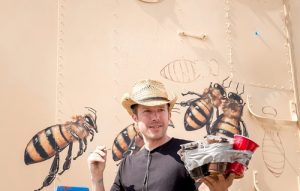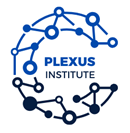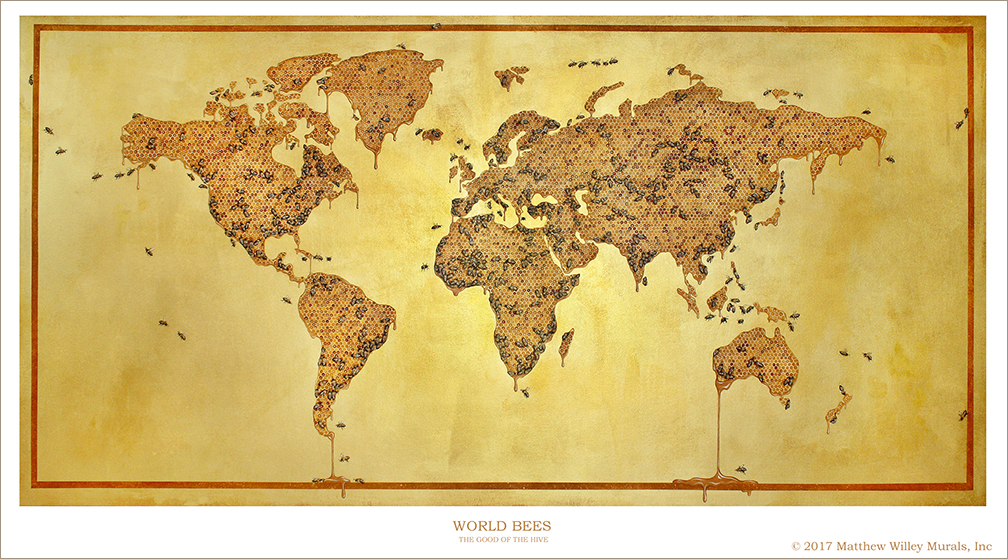“The health of a honey bee is based on the health of the hive, not the individual bee. Collective action is necessary for growth and expansion. Humans are the same way, although we rarely act like it. Many of the issues we face today are not divided by borders. In fact, bee health or pollination issues are more likely to be solved by transcending them.” Matthew Willey
When Melissa Stephenson, a Plexus Catalyst shared information about the New Hampshire Honey Bee Initiative, a community wide project she is leading with artist Kin Schilling, it seemed like the perfect topic for a summer conversation that links some of our favorite summer crops to complexity thinking. Bee health is a critical factor in many food ecosystems and creating new opportunities for awareness and proactive programs that promote and protect bee health is precisely what Melissa and Kin launched in Peterborough NH when they decided to participate in The Good of the Hive, a global initiative that raises awareness about the importance of honeybees and other pollinators through art and imagination also celebrates the beauty and power of human connection.
Melissa and Kin have a simple message, “No Bees, No Food.” Taking a lead role in sustaining our nation’s food supply, honeybees pollinate approximately 80% of all fruit, vegetable, and seed crops in the U.S.
 In August 2018, Matthew Willey, an artist and founder of For the Good of the Hive is heading to Peterborough N.H. to paint a mural depicting the beauty and elegance of honey bees on the outside entrance wall of Peterborough’s Community Center. Willey’s personal commitment to hand-paint 50,000 individual honey bees in murals and installations around the world is driven by the fact that 50,000 honeybees is the number necessary for a healthy, thriving hive. We will share photos of the completed project in September!
In August 2018, Matthew Willey, an artist and founder of For the Good of the Hive is heading to Peterborough N.H. to paint a mural depicting the beauty and elegance of honey bees on the outside entrance wall of Peterborough’s Community Center. Willey’s personal commitment to hand-paint 50,000 individual honey bees in murals and installations around the world is driven by the fact that 50,000 honeybees is the number necessary for a healthy, thriving hive. We will share photos of the completed project in September!
The Good of the Hive Initiative begins with the struggle of the honeybees, but it also views the hive as a metaphor for communities of people. Honeybees within the hive ‘think’ collectively; their immune system is collective: the health of the individual is based on the health of the collective. Whether that community is an actual honeybee hive or a community of human artists, kids in a school, military veterans, gay people, women with cancer, marginalized people, skateboarders, or the American people as a whole, the health and success of the individual relies heavily on the connections within the group– and consequently between the groups within the greater society.
 When we connect, we thrive. This is the essence of The Good of the Hive Initiative. Matt realized over the course of the last nine years of obsessing about honeybees that his own path as an artist was more aligned to its truth when it was being channeled toward connection–connection to the honeybees, as well as to the hive in which he lives. Matt is passionate about his belief that The Good of the Hive is about human connection around issues related to pollination and conservation more than it is about honey bees. The honeybee hive is a powerful metaphor for all communities of people and the issues they face together in their shared ecosystems.
When we connect, we thrive. This is the essence of The Good of the Hive Initiative. Matt realized over the course of the last nine years of obsessing about honeybees that his own path as an artist was more aligned to its truth when it was being channeled toward connection–connection to the honeybees, as well as to the hive in which he lives. Matt is passionate about his belief that The Good of the Hive is about human connection around issues related to pollination and conservation more than it is about honey bees. The honeybee hive is a powerful metaphor for all communities of people and the issues they face together in their shared ecosystems.
I see the bees as tiny connectors between me and the mystery and complexity of the rapidly changing world we live in. Faith, like bees (and art), can be put in a box, but their nature remains unpredictably wild and free despite any type of structure. The Good of the Hive is about inspiring actual people about the natural world around them. It is about remembering that through all of the muck going on out there in the world, it can be playful and even joyous to work toward healing. As an artist, it was a honeybee that became my muse through a personal experience, but I often put many other pollinators in my murals along with honeybees including hoverflies, bumbles, hummingbirds, butterflies etc.- Matt Willey
As Matt adds another one of his honeybees to the hive, he gets people excited about bees on a local community level. In Matt’s experience, inspiration does the work of educating, so he uses murals to inspire thoughts and engagement. And in no small way he is building awareness about the complex roles humans and bees play in keeping our world healthy and thriving.
Stay tuned! Matt will be speaking at the Smithsonian in August and who knows what else! You can find out more about the murals and Matt at For the Good of the Hive.
Last year a student filmmaker made a short film about The Good of the Hive, which speaks to the unique connection between humans and bees and the power we all have within us to change the world.
Here are some sweet facts….
• Honey is the only food produced by insects eaten by man.
• It takes 10,000 trips to and from flowers to make a teaspoon of honey.
• The honey bee’s wings beat at 200 beats per second.
• A honey bee can fly as fast as 15 miles per hour.
• A honey bee visits 50 to 100 flowers during one collection trip.
• Honey bees may visit up to 2000 flowers per day.
• On average, a worker bee flies the equivalent of 1-1/2 times the circumference of the earth. A common cause of death is the wearing out of their wings.
• Each honey bee makes about 1/12 of a teaspoon of honey in its life time.
• Honey bees gather nectar from two million flowers to make one pound of honey.
• A typical beehive can make up to 400 pounds of honey per year.
• Honey never spoils.
• A hive’s queen bee can lay up to 2500 eggs per day.
• Bees maintain a temperature of 92-93 degrees Fahrenheit in their central brood nest regardless of the temperature outside.
• A honey bee has 5 eyes: 3 simple eyes on top of its head, and 2 compound eyes
• Honeybees never sleep!
• One pound of beeswax can hold 20 pounds of honey

